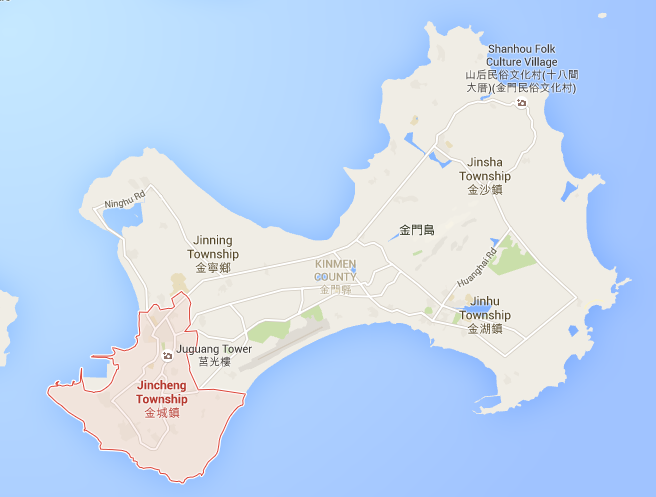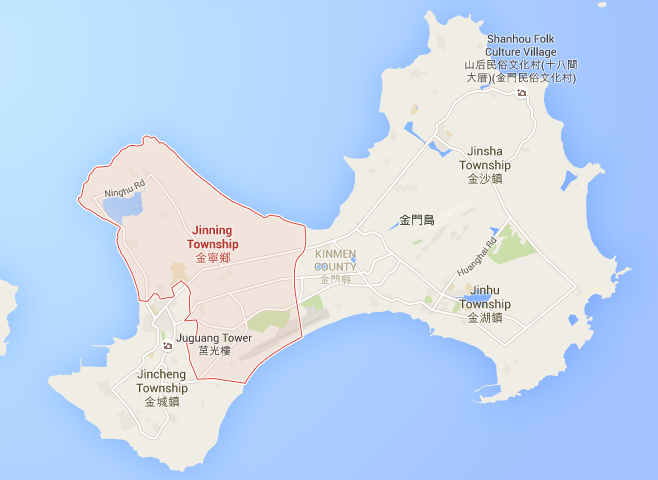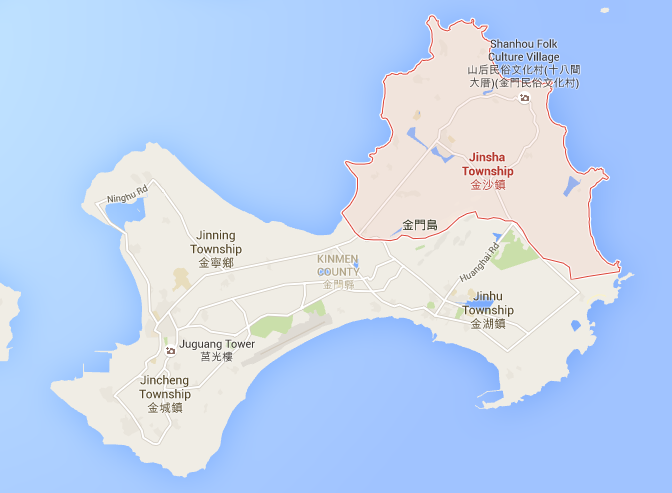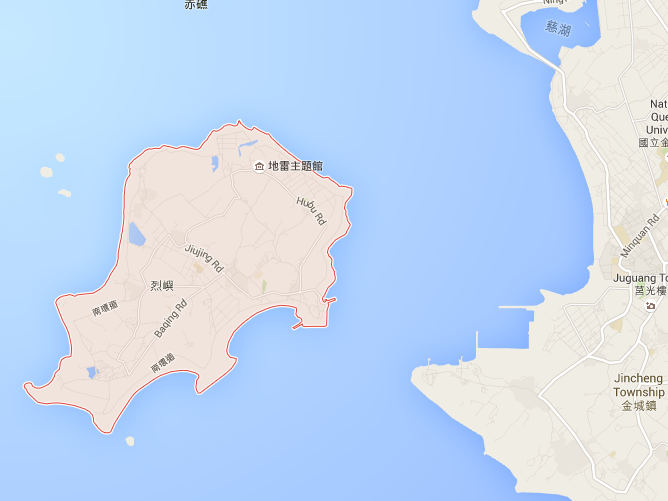
Living in Kinmen
Townships
Kinmen County has five major townships with three larger towns and smaller villages dispersed throughout the main island and Little Kinmen.
Jinning
Jinning is one of the townships on Kinmen, located really close to Jincheng. I usually tell people that if Jincheng is the "Manhattan" of Kinmen then Jinning is the "Brooklyn”. It feels a bit more residential to me, but it's still really close and easy to access all of Jincheng's amenities. There are two Fulbright apartments in the Jinning township. One of the apartments feels like it's more in Jincheng than Jinning and the other apartment is only a 5-minute scooter ride away from Jincheng. In Jinning there's a really beautiful 7/11 close to Jinding Elementary School, I would say it's a lot nicer than most 7's. There's a really good Thai restaurant, a more Western cafe, and a fusion-type restaurant called Ai yo Peng. You can visit Gunnintou village or the tunnels in Gunningtou, located by Gunningtou elementary school. Jinding and Jinning elementary schools are walkable from one of the Fulbright apartments in Jinning. Jinning is great because it's close to Starbucks, Sushi Express, and Carrefour, and depending on which apartment you're in, it's walkable to both. I really like living in Jinning because it's so easy to access all the different parts of the island.
Lieyu
This township encompasses all of Little Kinmen, a 10-minute cross-sea bridge west of Big Kinmen. Instead of Wind Lions, you’ll see Wind Roosters all over the island. Little Kinmen has an even tighter-knit community than Big Kinmen. There are not many chain stores, only one 7-11 and one Family Mart, but there are many small family-owned restaurants including a pizza place! What Little Kinmen lacks in urban development, it makes up for in charm and natural beauty. There are lakes, temples, tunnels, and rocky hills to explore. Along the coast of the entire island is a cement bike path with old army posts that have been turned into educational memorials. On a clear day, you can see the windows of the skyscrapers in Xiamen sitting only 3 miles across the strait. Little Kinmen is famous for its many taro farms and in the Fall they host an annual Taro Festival. There is even a restaurant that serves Taro ice cream! Schools in Lieyu Township include Shang Chi Elementary School and XiKou Elementary School!
Jinsha
Jinsha Township is on the northeastern side of Kinmen Island. It is one of the most rural areas of the island, filled with Kaoliang and wheat fields, beautiful birds, and lots of cows grazing. Being the smallest town, Shamei is a beautiful, charming, and cozy village. The center of town has a 7/11, a grocery store, a pharmacy, and small breakfast places. Near the bus station, you can find a lovely morning market selling fresh produce, seafood, and meat. Living in Jinsha means you might be neighbors with your students, or eat dinner in their family-run restaurant because the town is so small! There are only a few restaurants and they close early in the evening, so most ETAs living in Jinsha usually will eat in Shanwai or Jincheng, or cook their own food. There are beaches less than a 10-minute drive from the center of town, and a big lake with a bike and walking path around the perimeter. In Jinsha, you can find a famous village of the traditional style, called Shanhou Folk Village. You can also visit Mashan Observation Point, hike Taiwu Mountain or Wufu Mountain, and experience quiet farm life in Jinsha. Schools in Jinsha include Jinsha Elementary School, Shumei Elementary School, Jinsha Middle School, and Hepu Elementary School.
Jincheng
Jincheng Township is often considered the "hub" of Kinmen. An extremely small city-like feel where downtown is filled with yummy xialongbao stands, Vietnamese, Cantonese, and great beef noodle soup restaurants. In between food, you can also stop by the White Lion Square to catch a musical performance or just wander the streets of clothes and small, antique shops with a coffee from Island's in hand. The beach in Jincheng is just a few turns away and the view of Xiamen, China is one you can't miss. Many festivals, political events, Sports Days, and New Year Festivities are all celebrated in Jincheng.
To stay active and healthy, Jincheng is currently rebuilding its gym, located right near the middle school and about one minute from Jincheng High School. It's a great place to work and meet locals, PLUS it's practically free (when you terminate your membership you get your entire deposit back). On a typical weekday from 8-9 you can typically catch a Zumba group shredding their dance moves in the hallway of the Jincheng gym or you can join a game of pickup basketball, ping-pong, or badminton inside the gym's court.
Neighboring Jincheng are some really cool tourist spots with awesome views. Some include Juguang Tower; Oyster Island, an island you can only get to at low tide; Lake Ci, a beautiful run right near tanks on the beach; Guningtou Battlefield Museum, right by the Beishan Broadcasting Wall that was used to blast anti-communist propaganda; or the Jincheng Civil-military tunnel located right underneath the Jincheng Bus Station. With a majority of the restaurants in town and popular chains like Ba Fang Yunji dumplings or Coco bubble tea, a series of stationery stores, Physical Therapy, or doctor offices Jincheng has pretty much anything you could want and more.
Jinhu
Home to Shanwai, the second-largest town after Jincheng. Although it has only three main streets, it boasts some of the more famous restaurants on the island. Great danbing, fantuan, and douhua can be found here! Shanwai is also great for nature lovers, as Lake Tai (太湖) and the main entrance to Taiwu Mountain (太武山) are found here. Also found in Shanwai: Evverich luxury mall, the bank, scooter shop, and grocery stores.
Kinmen's Specialties
Windlions
Kinmen residents look to windlion gods to protect them from the harsh northeast winds of winter monsoons. Each village has its own windlion statue to protect it. Try to find all 150!
Food
Locals and travelers alike come to Kinmen to buy peanut candy, called gongtang (貢糖), taro chips, and taro ice. Oysters are also one of Kinmen's special foods, made into oyster noodles and pancakes. Little Kinmen is known for its abundance of taro, and there is an annual Taro Festival in September where ETAs have dug their own taro out from the ground in past years!
Kaoliang
Sorghum distilled into alcohol called gaoliang (高粱) is the island's most prosperous industry and is the drink of choice for most of the island today. Don't be surprised to see a lot of kaoliang flowing during any teacher's dinner, or be given a bottle as a formal gift. Bottles are given as gifts on holidays like Teachers’ Day, and events such as the Kinmen Half Marathon.
Maestro Wu Knives
After the war ended, the most famous knife shop in Kinmen, Maestro Wu's, began manufacturing knives out of the thousands of artillery shells locals had gathered. On the island, there are several Kinmen Knife Factories, where you can see Chinese bombshells smelted into knives!
Community
One of the most special parts of Kinmen is its community. Being a small island, ETAs are really able to become involved in the local community, inside and outside of school. Whether it be volunteering, tutoring, or just chatting with store and restaurant owners, there are endless opportunities to get to know the people of Kinmen. ETAs volunteer with both the elderly and with college students. Living in the same neighborhoods as their students, ETAs have the unique opportunity to see what a student’s home life is like. Expect to run into your students at the local 7-11 or grocery store, and don't be surprised if neighbors invite you over for dinner or if your co-teachers become your go-to travel buddies! Every conversation is an opportunity for cultural exchange.
Transportation
Although the island is small, Kinmen is mostly rural, so walking is not always the most convenient mode of transportation. To get around the island, ETAs can take the bus, rent a scooter, or a bike. Kinmen has several bus lines that run throughout the island. The main lines run between Jincheng and Shanwai, Shanwai and Shamei, and Shamei and Jincheng. Buses are very prompt and will leave right on time according to the schedule. Many ETAs decide to rent a scooter for the year, but it is not mandatory or necessary. In August, ETAs will have the opportunity to learn how to scooter and practice for the scooter test. Scootering is by far the most convenient way to get around and will save you significant travel time. Another option is biking--you will find that Kinmen is a very active community and it is common to see locals biking along the road. You can also take a 10-minute ferry ride from Shuitou Port to explore Little Kinmen, just 3 miles off the coast of mainland China. Starting from 6 am there is a ferry every 30 minutes between the two islands. It costs 60 NTD one-way, but it’s 120 NTD if you board with your scooter.
“Driver Lisence“ covered by Kinmen Alumni: https://youtu.be/UfRkvR3i7l8
Weather and Air Quality
As a sub-tropical island, Kinmen experiences hot and humid springs, summers, and falls, and a wet and cool winter. The island is humid all year round, particularly in the spring rainy season (from March to May). Rain is abundant during spring, which can affect your ability to scooter and dry your clothes! Beware of mold, especially around this time! Investing in dehumidifiers, silica gel packets, and other moisture-reducing items can help with mold prevention. Although temperatures rarely drop below mid-50°F, winter can feel very cold due to the excessive wind and lack of indoor heating. Do not underestimate the winter here! It is recommended to bring a lot of layerable clothing and a winter jacket. There is no indoor heating in Kinmen, and apartments can be quite drafty. The wind is extremely strong on the island, especially when scootering. Many ETAs choose to purchase small space heaters for their apartments. Another element to note is Kinmen's fog. Foggy season usually starts around February or March and will last through April or May. Exercise caution if traveling during these months; planes and ferries are often delayed or canceled due to the thick blankets of fog that cover Kinmen.
Taiwan generally exhibits low levels of pollution. However, with its close proximity to Xiamen, Kinmen can experience days with as high as 150-160 AQI. You can choose to wear a face mask, as most locals do if the pollution gets too high, but these days are rare.
Festivals
Kinmen residents observe all Taiwanese holidays and also celebrate the festivals unique to the island. Participating in Kinmen's events and festivals is a wonderful and enriching way to experience its culture and learn about Kinmenese history, identity, and customs. Almost every month you'll find another celebration happening! A few highlights include Teacher's Day, the Mid-Autumn Festival, the Taro Festival, the Kinmen Marathon, the Chinese New Year, and the Dragon Boat Festival.
Activities
Volunteering and Community Service
Due to its small and close-knit community, volunteering in Kinmen is both fun and rewarding. The amount of volunteer opportunities and community service initiatives to get involved with are vast and diverse. In the past year, ETAs have volunteered to do weekend story-time in local libraries, organized beach cleanups, served at the local elderly home, and coached basketball teams. In addition, ETAs can also volunteer in Vocational School Sharing, through this sharing, local students can have more chance to see different culture and also got inspired to explore other countries.
The A to Z Collective was started in the 2015-2016 academic year.
Language and Culture Classes
The local college, National Quemoy University will open Mandarian classes for foreigners every year. You can sign up and participate the Mandarian level test, the Mandarian department will base on your level to design classes. You are also encouraged to set up your own language exchange and tutoring sessions with anyone you meet in Kinmen. Outside of language exchange, tutoring offers an opportunity for friendship and cultural exchange.
Being Active in Kinmen
In general, Kinmen is an active community and it's relatively easy to find people with which to hike, run, bike, play basketball or lift weights. Most informal sports or outdoors groups use LINE or Facebook to communicate . You can find many runners around Lake Tai in Shanwai or on the coastal bike path just west of Jincheng. Lake Ci provides a spacious area for running and bird watching. For more isolated but beautiful runs, you can run around the reservoir and farms in Shamei or start in Mazu Park and head on a scooter path north through small villages like An Bian. However, some locals running in rural parts carry along a stick just in case of problems with dogs, as there are many guard dogs for houses and farms (although most are tied up and there haven’t been any incidents, just some startles!). For hiking, visit Taiwu Mountain, which has multiple well-maintained hiking paths that lead to a temple at the top of the mountain. Both Jincheng and Shanwai have local gyms with a lifetime (yes, lifetime) membership of just 1200 NT.
Sights
This map displays a number of different sights, but there is always more to explore on the island. Even after a year in Kinmen, you will realize you haven't seen enough of the island. Feel free to use these suggestions, but make sure to get out and adventure on your own!
Kinmen has a wide array of sights for you to visit and explore. There is something here for everyone, whether you're a history buff, nature-lover, avid biker, photographer, or just love to lounge on the beach (you're never more than a 5-10 minute scooter ride from the sand and waves!).
Hike Taiwu Mountain (太武山) located in the center of the island. Houhu Beach (后湖海濱公園) is the best for swimming, but there are numerous other beaches scattered throughout Kinmen's coast. Each year ETAs discover more and more favorite and private beaches. Kinmen is also known for its traditional villages, characterized by beautiful red brick-style houses. One of the most well-preserved of these villages is Shanhou Cultural Village (山后民俗文化村), located in Jinsha Township. Maoshan Pagoda (茅山塔) offers stunning views, while Zhaishan Tunnel (翟山坑道) is a prominent remnant of Kinmen's rich military history.
Food and Entertainment
Most food on Kinmen is Taiwanese and Kinmenese. Western food is not difficult to find, but it is uncommon and not authentic. There are two small Costcos and a new Carrefour that sell Western products, and a few restaurants provide American-style brunch. There are two Starbucks on the island, but other than that, no other Western chains can be found in Kinmen (re: McDonald’s). Not to worry, though! On the main island of Taiwan, you can find all your comfort food needs, and the Taiwanese food in Kinmen is very special and delicious. East Asian fast-food chains such as Mos Burger and Laya Burger can be found in Jincheng, as well as several pizza parlors. Restaurants across Kinmen cater a variety of international cuisines, and there are notably a number of Korean, Japanese, Vietnamese, Chinese (i.e. Sichuan), Indonesian, and even Italian eateries. You will be sure to figure out your favorite places and likely discover new ones. Never underestimate restaurants run out of families’ living rooms, and always be willing to try what the locals are eating!
There are many family-style restaurants that are friendly and accommodating for big groups of ETAs. You can find quick, small restaurants that sell fried chicken, dumplings, fried noodles or rice, and other “fast” food options. All around the island you can find many milk tea shops. Historically, there are large populations of Buddhists and Taoists that promote a vegetarian diet. You'll find that most restaurants are very accommodating and will make a dish vegetarian for you when requested. However, there are some differences to note between a western vegetarian and a Taiwanese vegetarian: in Taiwan, vegetarians believe garlic, scallions, leeks and onions are not vegetarian. Any of the mentioned seasonings will not be found in vegetarian restaurants. Many schools also provide vegetarian meals for students and teachers who follow this practice (and ETAs who are vegetarian!) Although there are many vegetarian options in Taiwan, it is not as easy in Kinmen. There are a few vegetarian restaurants on the island, but often times at regular restaurants it can be difficult to communicate dietary restrictions. ETAs recommend learning the Chinese words for what you can and can’t eat! The grocery stores on the island also provide many inexpensive vegetables and fruits, making it an option for ETAs to make vegetarian food in their apartments.
Entertainment on Kinmen is very different from Taiwan. There is no night market or strong nightlife on the island because most of the people living here are not young adults looking for entertainment. However, there is actually an "Irish pub" and a couple of bars on the island. Spend a night out at one of the many KTV establishments or have a beach party! Kinmen also has two movie theaters that will show all the latest films playing in Taiwan. On the weekends, ETAs get together in their apartments or spend time together exploring the island.
Shopping
In this map you'll find a list of grocery stores, import stores, stationery stores, and places to buy other miscellaneous items such as electronics or household goods. This is not a complete list, but it is a good start to cover your basic needs.









